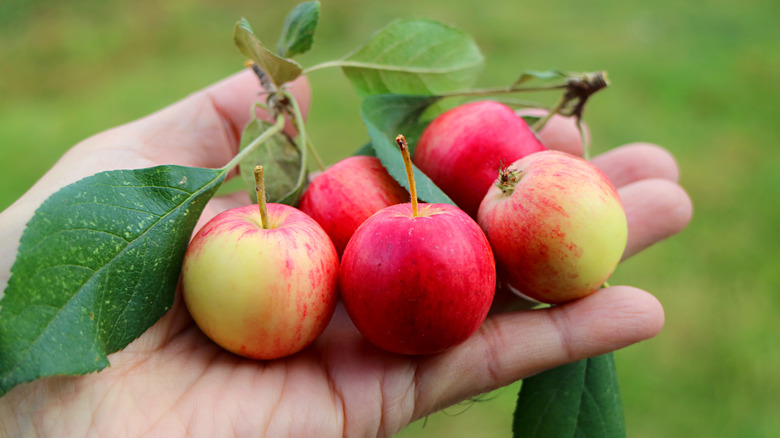What To Keep In Mind Before Attempting To Make Crab Apple Cider
In the colder months, there aren't many other drinks that sell out in the grocery stores quite as quickly as apple cider. While apple cider in the United States varies from apple cider around the globe (the U.S. calls this version hard cider), the non-pasteurized, non-alcoholic beverage we reach for in the fall is a spiced, sweet, juice-like drink that can be customized with endless species of apples.
If you've ever tasted a fresh crab apple, then you likely would have never even dreamed of making cider out of these miniature-sized fruits — they taste bitter, sour, and the texture is akin to cotton. This is due to their acidity and tannin levels (which are polyphenols that you'd find in drinks like coffee and wine). However, many cider experts agree: The qualities that make these apples brutal to eat fresh are the same aspects that make them fantastic in a cider. The acidity and tannins are a wonderful balance to any sweetness and added spices.
The main thing to keep in mind when creating a batch of crab apple cider is that the time of picking and the size of the apple do matter. The longer crab apples are left on the tree throughout the autumn season, the smoother the tannins become, which makes for a better cider. The end of the fall is typically the ideal time for picking. By the same token, smaller apples, reminiscent of cherries, tend to be more bitter.
Tips for using crab apples in cider
Because of the crab apple's notoriously bitter taste, you'll often see crab apple trees untouched until all of the fruits have fallen and rotted. Moreover, their small size makes working with them a bit more tedious compared to other orchard apples. You'll be glad to know that this means there are plenty of crab apples to go around, and if you have a crab apple tree, homemade apple cider is even easier to achieve.
When crafting homemade crab apple cider, the process begins by juicing the apples, which can prove rather difficult as they don't have much juice to begin with. A way around this is to cook the apples to extract the juice. Simply simmer the apples in water until they become soft, then use a potato masher to create a pulp. Simmer for a few more minutes to extract extra juice. Using a cheesecloth, strain the liquid into your preferred jar. Now, the juice is ready to be mulled on the stove with herbs and spices, sweetener, and any other additions you'd like.

